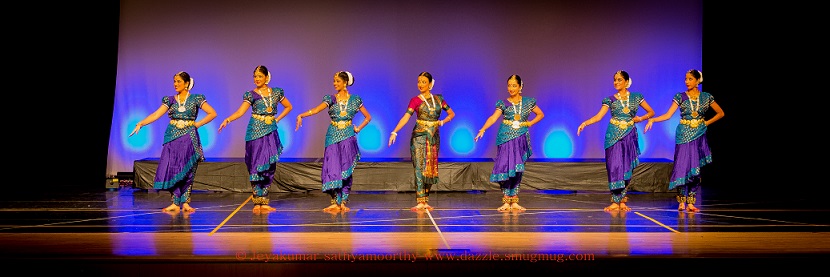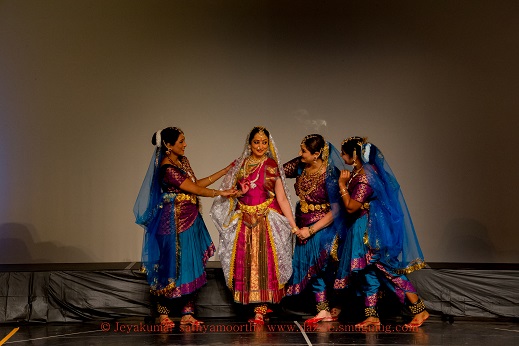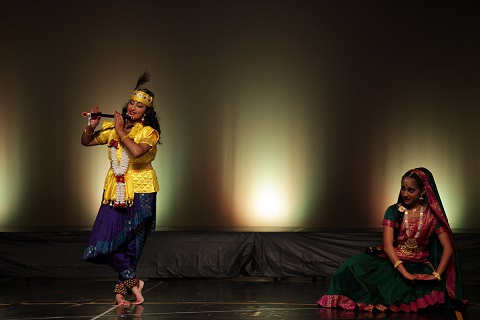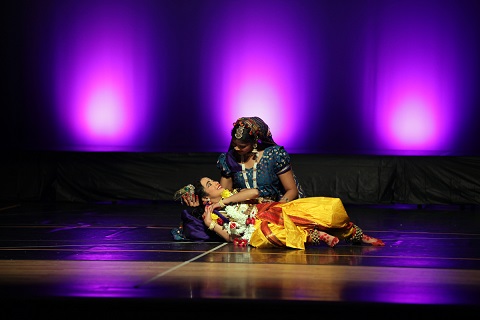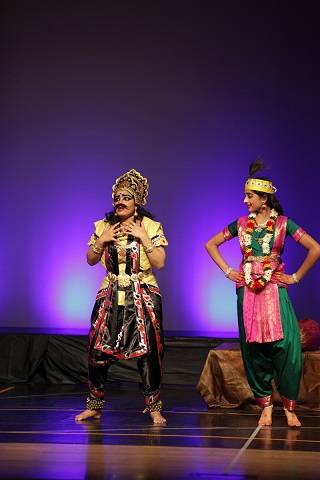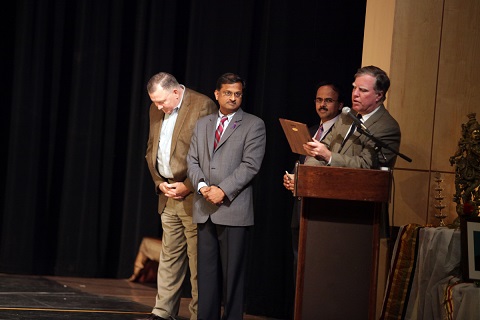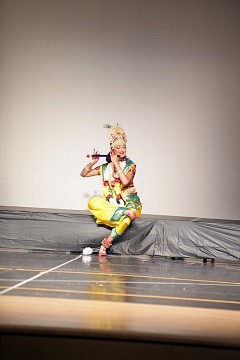Contribute
| Maya Madhavam – A Spectacular Bharatanatyam Dance Ballet Based On The Story Of Lord Krishna |
Nagendra Rao
10/23/2014
It is not often that we see cultural events where tickets are sold out 4 weeks prior to the show. Lasya School of Dance in Shrewsbury pulled off such a dazzling dance ballet on October 5th at Ashland High School in front of 500+ packed audience. The event christened “Maya Madhavam – A Dance Ballet†marked the 10th anniversary of the dance school, established in 2004 by Smt. Sapna Krishnan. Lasya’s mission is to promote awareness of Indian culture and arts among students and encourage them to express themselves through the medium of dance. Students are given sound training in various aspects of Bharatanatyam with emphasis to the rich tradition of this ancient dance form.
Maya Madhavam was a benefit event where all the proceeds were contributed to the UMass Memorial Hospital Center for Research for Pancreatic Cancer. Sapna Krishnan dedicated this event to her mother who was a victim of this disease. The event managed to raise more than $11,000 for a great cause that will benefit medical research. Dr. Giles Whalen, director of the dept. of Oncology, UMass spoke on the occasion and thanked her for her generous contribution. He presented her a plaque recognizing her school’s efforts for supporting the cause.
The ambience created by 70 dance students narrating the everlasting mythological tale of Lord Sri Krishna was magical. It recreated the spiritual, and mythological stories, woven by rhythm and rhapsody, and recounted the tales of the mysticism, and charisma of Lord Krishna.
The story began after a lovely invocation piece in the courts of King Ugrasena, the righteous father of Kamsa who, on the other hand, is the personification of evil power. Such was the cruelty of Kamsa that he imprisoned his own father and brought misery to the land of Mathura and its people. The green fields of Mathura became barren, and people roam on the streets, hungry, and sick. The magnificent persona and tyranny of Kamsa was beautifully represented by Sai Mahima, a freshman at UConn. The ballet artistically showed how Kamsa knew from a heavenly messenger (portrayed by Sanjana Rao) that the 8th born of Devaki, his devoted sister, would finally be the one who would bring death to him. Kamsa went on a chariot ride with Devaki and Vasudeva when this message was disclosed to him. The portrayal of the chariot ride by a group of dancers and Kamsa’s dismay on hearing the news was exquisite and drew gasps of astonishment from the viewers.
An elaborately choreographed representation of the birth of the seven children of Devaki, wife of Vasudeva, and their slaughter by Kamsa followed the first scene. The 8th child, Lord Krishna’s birth at Mathura and his journey to in Vasudeva’s arms to Gokulam was depicted beautifully. The dramatization of the multi-headed serpent Adisesha who covered the baby with its hood, while the River Yamuna parted to make way for him to cross the river was outstanding and held the audience in rapturous wonder.
There were many lovely scenes that mesmerized the audience. Such as the playful naughtiness of Krishna with Yashoda, very lovingly represented by Aishwarrya Nambi, a junior at Mass Academy, and his stealing of a hung pot of butter by standing on his friends’ backs. And the exasperation of his mother and gopikas who he regularly teased were depicted wonderfully by young dancers. The young Krishna himself became very dear to everyone in Brindavan and was radiantly presented by the youngest daughter of Smt. Sapna Krishnan, Madhumita Nambiar, a sixth grader at Sherwood Middle School. Creativity was at its best when two students, Ilakya Senthilkumar and Rinija Raja switched the roles alternately portraying the cunning beautiful Poothana and her deadly evil counterpart , coming to Gokulam , killing babies in the village by nursing them with her poisonous milk.
One of the most picturesque representations in the dance ballet was the taming of multi headed snake Kaliya who had inhabited the River Yamuna, devouring any living being who drank the poisonous water from the river. Lord Krishna danced on its hood with abundant glory and unsurpassed beauty. This was artistically choreographed and shown by a group of young talented dancers. Krishna as a young boy was portrayed by Nilanjana Nambiar, Madhumita’s elder sister, a freshman at Shrewsbury High School.
As Krishna grew up his exploits reached Kamsa at Mathura who was constantly tormented by dreams of Krishna and how he would finally kill him. In the finale of the dance Krishna leaves Brindavan for Mathura to kill Kamsa and hand back the throne of Mathura to King Ugrasena. Radha and Yashoda are disappointed and their dismay and loneliness was skillfully shown in dance form. The grown up form of Lord Krishna was represented with a scintillating solo dance by Niveda Baskaran a long time disciple of Lasya School of Dance, now a senior at Brandeis University.
The slaying of Kamsa by Krishna and the victory of the Lord was presented in a breathtaking sequence. It signified the triumph of good over evil, so relevant in today’s context. Throughout the ballet emotions of love, cruelty, loneliness, adoration and anger kept the audience enthralled and a stand up ovation as the dance concluded showed the enjoyment of the packed audience.
The narration ended with a recitation of the verse - Paritranaya sadhunam vinasaya cha dushkritam; Dharma-samsthapanarthaya sambhavami yuge - Whenever the balance of the universe is disturbed by external interference from any of its parts, then I (the Lord Krishna) reveal Myself as the Power of eternal balancing. For the protection of those who are in harmony, and the rectification of everything disharmonious, I incarnate Myself at every juncture of time.
Maya Madhavam was not only a beautiful display of the ancient art of Bharatanatyam. It was a visually rich, technologically advanced, contemporary dance ballet where pre-recorded audio tracks, state of the art lighting, voiceover and backlit computer imagery was used artistically to support the variety of dances and emotions of the story enacted on stage.
You may also access this article through our web-site http://www.lokvani.com/
